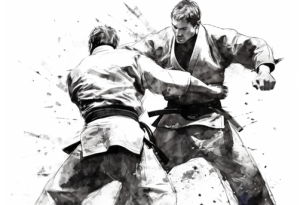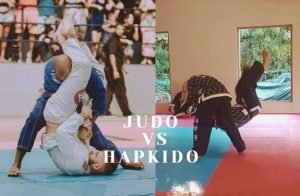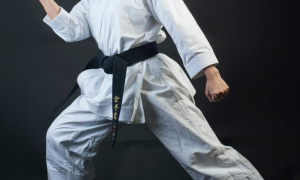
When most people think of karate, images of powerful strikes and dynamic kicks often come to mind. However, there’s more to this martial art than meets the eye. Beyond its striking prowess, karate encompasses a range of grappling techniques that contribute to its holistic effectiveness in combat scenarios. While the misconception persists that karate is solely a striking martial art, delving into its grappling dimension reveals a more comprehensive approach to self-defense and competition.
Table of Contents
Toggle![]()
Grappling in Karate: An Overview
Looking back through the annals of history, grappling has always been an integral part of karate, particularly within the context of Okinawan styles. These early traditions included an array of throws, joint locks, chokes, and other grappling concepts, highlighting the diverse skill set that karateka possess.
Grappling serves as a strategic complement to striking techniques, offering a means of maintaining control over an opponent at close range. In situations where strikes might be less effective, grappling provides a valuable alternative for asserting dominance. It’s important to note that while all major karate styles incorporate some degree of grappling influence, the extent of emphasis can vary significantly between schools. This diversity in approach further enriches the tapestry of karate’s martial heritage.
![]()
Karate Grappling Techniques
Karate Grappling Techniques at a Glance:
| Technique Category | Examples |
|---|---|
| Throws | Hip Throws, Leg Sweeps, and Shoulder Throws |
| Takedowns | Foot Sweeps and Leg Grabs |
| Joint Locks | Elbow Locks, Wrist Locks, Shoulder Locks, and Finger Locks |
| Chokes | Cross Collar Chokes, Rear Naked Chokes, and Triangle Chokes |
| Pins | Top Position Control and Immobilization |
| Ground Fighting | Positional Techniques, Escapes, and Submissions |
Throwing Techniques
Karate incorporates a range of throwing techniques that leverage body positioning and leverage to unbalance opponents and bring them to the ground. Notable throws include:
- Hip Throws: Utilizing hip movement and leverage to throw an opponent over the hip.
- Leg Sweeps: Employing leg sweeps to disrupt an opponent’s balance and bring them down.
- Shoulder Throws: Using the shoulders to execute forceful throws, often from a clinch position.
Takedowns
Takedowns are tactical moves that involve destabilizing an opponent and taking them down to the ground. Key takedowns include:
- Foot Sweeps: Swiftly sweeping an opponent’s foot to disrupt their stability and bring them down.
- Leg Grabs: Grasping an opponent’s leg and leveraging it to unbalance and take them down.
Joint Locks
Grapplers skilled in joint locks can control and manipulate an opponent’s joints using leverage. Common joint locks include:
- Elbow Locks: Applying pressure to an opponent’s elbow joint to immobilize or submit them.
- Wrist Locks: Manipulating an opponent’s wrist joint to gain control and submission.
- Shoulder Locks: Using techniques to hyperextend or immobilize the shoulder joint.
- Finger Locks: Applying pressure to fingers to gain control or submission.
Chokes
Chokes are effective grappling techniques that involve restricting an opponent’s air or blood supply to force submission. Essential chokes include:
- Cross Collar Chokes: Applying pressure to an opponent’s throat using the collar of their uniform.
- Rear Naked Chokes: Restricting the opponent’s neck from behind to induce submission.
- Triangle Chokes: Employing legs to create a triangular configuration to strangle the opponent.
Pins
Pinning an opponent to the ground immobilizes them and sets the stage for further control or submission. Pins include:
- Top Position Control: Using body weight and positioning to control an opponent from the top.
- Immobilization: Restricting an opponent’s movement through body control, pressure, and leverage.
Ground Fighting
Ground fighting skills are crucial for combat scenarios that transition to the ground. This includes:
- Positional Techniques: Learning to gain advantageous positions while on the ground.
- Escapes: Techniques to free oneself from unfavorable positions or submissions.
- Submissions: Applying joint locks or chokes to force the opponent to submit.
![]()
Grappling by Karate Style
| Karate Style | Grappling Focus |
|---|---|
| Kyokushin | Clinch fighting, Throws, and Submissions |
| Shito-Ryu | Throws, Joint locks, and Chokes |
| Shorin-Ryu | Sweeps and Locks |
| Shotokan | Judo-inspired throws |
| Goju-Ryu | Throws, Takedowns, and Submissions |
Kyokushin
Is a full-contact style of karate founded by Masutatsu Oyama, it places a significant emphasis on grappling techniques. This emphasis is evident in its training approach and sparring methodology. In Kyokushin, clinch fighting, throws, and submissions are integrated into the curriculum to develop robust grappling skills. Full-contact sparring sessions provide practitioners with the opportunity to test and refine their grappling techniques in a realistic combat environment. This approach not only enhances a practitioner’s overall combat effectiveness but also builds confidence in their ability to manage close-quarters engagements.
Shito-Ryu
Shito-Ryu stands out among karate styles due to its comprehensive grappling program. This style encompasses a wide range of grappling techniques, including throws, joint locks, and chokes. Shito-Ryu practitioners undergo systematic training in these techniques, allowing them to seamlessly integrate grappling into their overall skill set. The emphasis on joint locks and chokes provides practitioners with tools for both controlling opponents and submitting them when necessary. This well-rounded approach contributes to Shito-Ryu’s reputation for versatility in self-defense scenarios.
Shorin-Ryu
Shorin-Ryu, deeply rooted in Okinawan traditions, maintains a connection to classic karate grappling techniques. This style emphasizes on sweeps and locks, techniques that have been refined over generations. These techniques reflect the historical ties of Shorin-Ryu to the traditional practices of Okinawan martial arts. By preserving and passing down these techniques, Shorin-Ryu practitioners honor the legacy of their martial art while equipping themselves with effective close-quarters combat skills.
Shotokan
Although primarily known for its striking techniques, certain schools of Shotokan karate recognize the value of grappling and incorporate judo-inspired throwing techniques into their repertoire. These throwing techniques enhance Shotokan practitioners’ ability to off-balance opponents and take advantage of openings created by striking techniques. While not the central focus, the integration of throwing techniques in select Shotokan schools demonstrates the adaptability of the style and its willingness to incorporate elements from other martial arts.
Goju-Ryu
Goju-Ryu’s inherent focus on close-range combat naturally lends itself to grappling applications. This style emphizises throws, takedowns, and submissions as part of its training regimen. The close-quarters nature of Goju-Ryu’s techniques makes it well-suited for scenarios where striking might be less effective. By practicing throws and takedowns, Goju-Ryu practitioners learn to control opponents and create opportunities for follow-up techniques. This emphasis on both striking and grappling makes Goju-Ryu a versatile and well-rounded martial art.
![]()
Benefits of Grappling Training in Karate
Integrating grappling techniques into karate training offers a range of advantages that enhance both the martial artist’s skill set and overall combat effectiveness.
- Holistic Self-Defense Skills: Enhances ability to handle various combat scenarios.
- Close-Quarters Control: Allows effective control in close-range combat.
- Safer Sparring: Reduces injuries in training through controlled techniques.
- Complementary Skills: Offers an alternative to striking in certain situations.
- Physical Enhancement: Develops strength, endurance, and flexibility.
- Synergy with Striking: Creates a dynamic combination of striking and grappling.
- Preservation of Tradition: Keeps the holistic approach of Okinawan martial arts.
Holistic Self-Defense Skills
Incorporating grappling into karate training significantly broadens a practitioner’s self-defense toolkit. While striking techniques are crucial for maintaining distance and offense, grappling equips martial artists to address a wider range of combat scenarios. A well-rounded martial artist proficient in both striking and grappling possesses the adaptability to effectively respond to various threats, whether in a stand-up exchange or a close-quarters confrontation. This versatility enhances their overall effectiveness as defenders and ensures that they can confidently navigate diverse self-defense situations.
Close-Quarters Control and Restraint
Grappling techniques excel in close-quarters combat situations where maintaining control over an opponent is of paramount importance. By learning how to manipulate an opponent’s joints, execute throws, and apply locks, karateka gain the ability to manage adversaries at an intimate range. This control minimizes the risk of immediate retaliation and allows martial artists to dictate the pace of the encounter. Effective grappling not only provides defensive advantages but also opens opportunities for restraint and non-lethal force, crucial for law enforcement and security professionals.
Safer Sparring and Reduced Excessive Striking
One of the significant benefits of integrating grappling into karate training is the element of control it brings to sparring sessions. Traditional karate sparring can sometimes lead to injuries due to the intensity of striking exchanges. By incorporating grappling techniques, practitioners can engage in controlled sparring with less emphasis on excessive striking. This controlled environment fosters a safer training experience while still allowing practitioners to refine their combat skills. It also facilitates the exploration of various techniques in a less risky manner.
Complementary Skills in Case Striking Is Not Viable
Real-world situations can vary, and there may be times when executing strikes is not a viable option. Limited space, crowded environments, or legal considerations might make striking less practical. Grappling techniques offer an alternative means of neutralizing opponents without solely relying on striking. In such scenarios, a well-executed throw, joint lock, or chokehold can be instrumental in subduing an aggressor while minimizing harm. This versatility enables martial artists to adapt their tactics to the specific circumstances they face.
Physical Strength, Endurance, and Flexibility Enhancement
Grappling demands a unique set of physical attributes that go beyond striking techniques. Strength, endurance, and flexibility are essential for executing throws, maintaining control, and escaping unfavorable positions. Training in grappling not only hones these attributes but also contributes to an overall improvement in a martial artist’s physical capabilities. Increased strength aids in executing techniques effectively, enhanced endurance sustains performance during longer engagements, and improved flexibility allows for seamless transitions between techniques.
Synergy with Stand-Up Striking Skills
Integrating grappling seamlessly complements stand-up striking techniques, creating a dynamic synergy between the two disciplines. Martial artists who can seamlessly transition between striking and grappling keep opponents off balance and unsure of their next move. A combination of strikes and takedowns keeps adversaries guessing, making the martial artist’s approach unpredictable. This fluid transition also enables practitioners to exploit openings created by their opponent’s defensive reactions, further enhancing their overall combat effectiveness.
Preservation of Okinawan Roots and Holistic Approach
Okinawan martial arts have a rich history of holistic training that encompasses both striking and grappling techniques. Embracing grappling techniques in modern karate training pays homage to these roots and ensures that the martial art retains its comprehensive nature. By incorporating grappling, practitioners honor the legacy of traditional practices while adapting them to contemporary self-defense needs. This approach not only provides a well-rounded martial education but also deepens the practitioner’s connection to the history and philosophy of karate.
![]()
Real-Life Examples and Practical Considerations
![]()
Quick Recovery: A Core Tenet of Karateka
Karate practitioners are ingrained with the principle of swift recovery. If knocked down during a fight, the first instinct is to rise promptly and resume the engagement. This emphasis on rapid recovery reflects the karateka’s proactive approach to combat, ensuring minimal vulnerability and maximizing their readiness to counteract.
Influence of MMA and Grappling Arts
The rise of MMA and the prominence of grappling arts like Judo and Brazilian Jiu-Jitsu have underscored the significance of ground fighting techniques. While these disciplines highlight the effectiveness of ground strategies, it’s crucial to contextualize their applicability.
Staying on Your Feet: A Strategic Imperative
Despite the growing fascination with ground fighting, it’s important to recognize that, in many situations, the first person to the ground is often at a disadvantage. Karate training encourages practitioners to maintain an upright stance whenever possible, allowing them to capitalize on their striking and movement capabilities. While ground fighting skills are valuable, staying on one’s feet remains a strategic imperative in numerous self-defense scenarios.
![]()
Addressing FAQs About Karate Grappling
![]()
Does Karate Have Grappling?
Absolutely, grappling is a fundamental component woven into the fabric of karate, particularly within the realm of Okinawan styles. From the earliest iterations of karate, practitioners have been equipped with a diverse arsenal of techniques, including throws, joint manipulations, and various grappling concepts. These elements contribute to the well-rounded nature of karate as a martial art, showcasing its adaptability and comprehensive approach to combat.
Does Any Karate Include Grappling?
Indeed, virtually all styles of karate integrate grappling techniques and principles to varying degrees. While striking remains a cornerstone, the inclusion of grappling techniques enriches the martial artist’s repertoire. Styles such as Kyokushin, renowned for its emphasis on full-contact sparring, delve into clinch fighting, throws, and submissions. Shito-Ryu stands out with an integrated grappling curriculum that encompasses throws, joint locks, and chokes. Shorin-Ryu, rooted in tradition, retains classic grappling techniques. Even styles like Shotokan, which primarily emphasize striking, incorporate judo-inspired throws in select schools. Goju-Ryu, with its close-range fighting methods, skillfully intertwines throws, takedowns, and submissions.


